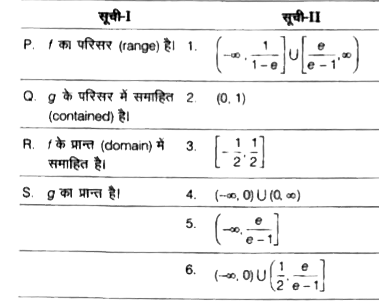माना द्विघात समीकरण x2sinθ−x(sinθcosθ+1)+cosθ=0(0<θ<45∘), के मूल α तथा β(α<β) है, तो ∞Σn=0(αn)+(−1)nβn बराबर है
11+cosθ+11−sinθ
11+cosθ−11−sinθ
11−cosθ+11+sinθ
11−cosθ−11+sinθ
The correct Answer is:C
Step by step video, text & image solution for माना द्विघात समीकरण x^(2) sin theta - x (sin theta cos theta + 1)+ cos theta = 0 (0 lt theta lt 45^(@)), के मूल alpha तथा beta (alpha lt beta) है, तो underset(n=0)overset(oo)Sigma (alpha^n) + ((-1)^(n))/(beta^(n)) बराबर है by Maths experts to help you in doubts & scoring excellent marks in Class 12 exams.
Updated on:21/07/2023Topper's Solved these Questions
- JEE MAIN 2019BOOK - JEE Main & Advanced (Hindi Medium)CHAPTER - JEE MAIN 2019EXERCISE - 12 January Shift-I
30 Videos
- JEE MAIN 2019BOOK - JEE Main & Advanced (Hindi Medium)CHAPTER - JEE MAIN 2019EXERCISE - 12 January Shift-II
30 Videos
- JEE MAIN 2019BOOK - JEE Main & Advanced (Hindi Medium)CHAPTER - JEE MAIN 2019EXERCISE - 11 January Shift - I
30 Videos
- JEE ADVANCED सोल्वड पेपर्स 2018 BOOK - JEE Main & Advanced (Hindi Medium)CHAPTER - JEE ADVANCED सोल्वड पेपर्स 2018 EXERCISE - पेपर 2 (खण्ड 3)
4 Videos
- JEE MAIN QUESTION PAPER 2013BOOK - JEE Main & Advanced (Hindi Medium)CHAPTER - JEE MAIN QUESTION PAPER 2013EXERCISE - PART-C - गणित (MATHEMATICS)
30 Videos
Similar Questions
यदि z−αz+α(α∈R) एक शुद्ध रूप से काल्पनिक संख्या है तथा |z|=2 है तो α का एक मान है
View Solutionयदि λ के उन सभी वास्तविक मानो, जिनके लिए बिन्दुओ (−λ2,1,1),(1,−λ2,1) तथा (1,1−λ2) से होकर जाने वाला एक समतल, बिन्दु (−1,−1,1) से भी होकर जाता है, का समुच्चय S है, तो S बराबर है
View Solutionसमुच्चय {1,2,….,11} से दो पूर्णांक यादृच्छिक लिए गे हैं। दिया है कि ली गई संख्याओं का योग सम है , दोनों संख्याओं के सम होने की सप्रतिबन्ध (conditional) प्रायिकता है
View Solutionमाना की E1={x∈R:x≠1औरxx−1>0} और E2={x∈E1sin−1(loge(xx−1)} एक वास्तविक संख्या (real number) है|
(यहाँ प्रतिलोम त्रिकोणमितीय फलां (inverse trignometric function) sin−1x,[−π2,π2] में मान धारण करता है|
माना की फलन: f:E1→R,f(x)=loge(xx−1) के द्वारा परिभाषित है
और फलन f:E2→R,g(x)=sin−1lloge(xx−1) के द्वारा परिभाषित है|

दिए हुए विकल्पों में से सही विकल्प है
View Solutionदो समान्तर समतलों 2x+y+2z=8 तथा 4x+2y+4z+5=0 के बीच की दूरी है|
View SolutionIf cos(θ−α)=aandsin(θ−β)=b(0<θ−α,θ−β<π/2), then prove that cos2(α−β)+2absin(α−β)=a2+b2
View SolutionLet α and β be the roots of the quadratic equation xsin2θ−x(sinθcosθ+1)+cosθ=0(0≤θ≤45∘)andα≤β . Then∞∑n=0(αn+(−1)nβn) is to equal to
View SolutionIf α and β are roots of x2−(√1−cos2θ)x+θ=0, where 0<θ<π2. Then limθ→0+(1α+1β) is
View Solutionयदि द्विघाती समीकरण, x2+xsinθ−2sinθ=0,θ∈(0,π2), के मूल α तथा β हैं , तो α12+β12(α−12+β−12).(α−β)24 बराबर है
View SolutionConsidered three points P= (-sin(beta - alpha), - cos beta), Q=(cos(beta-alpha), sin beta) And R=(cos(beta-alpha + theta), sin(beta-theta)) is Where 0 lt alpha, beta, theta lt pi/4
View SolutionLet α and β be the roots of the quadratic equation x2 sin θ−x(sinθcosθ+1)+cosθ=0(0<θ<45∘), and α<β.
Then Σ∞n=0(αn+(−1)nβn) is equal to
View SolutionIf cos(θ−α)=aandsin(θ−β)=b(0<θ−α,θ−β<π/2), then prove that cos2(α−β)+2absin(α−β)=a2+b2
View SolutionConsidered quadratic equation x^(2) sin theta - x(sin theta cos theta +1) cos theta = 0 (0 lt theta lt 45^(@)) , The origin of alpha And beta (alpha lt beta) If so underset(n=0)overset(oo)Sigma (alpha^(n) + ((-1)^(n))/(beta^(n))) Is equal
View Solutionमाना तीन बिन्दु
P=(−sin(β−α),−cosβ),Q=(cos(β−α),sinβ) तथा R=(cos(β−α+θ),sin(β−θ)) है, जहाँ 0<α,β,θ<π4
View SolutionIf α and β are roots of x2−(√1−cos2θ)x+θ=0, where 0<θ<π2. Then limθ→0+(1α+1β) is
View Solution
